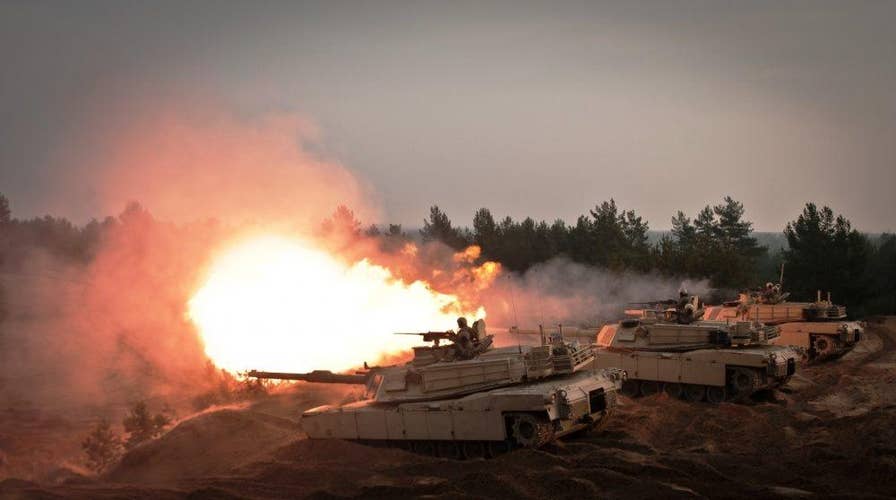Chilling World War III 'wargames' show US forces crushed by Russia and China
According to research organization RAND, should a major conflict arise in Russia and China's 'backyards,' US forces would be crushed by a vast array of both conventional and cyber weapons. Based on a variety of wargame simulations, a clash with Russia in the Baltic states would result in the rapid defeat of U.S. forces and their allies. Simultaneously, a Chinese invasion of Taiwan, while a massive military gamble for China, would also pose a huge challenge for U.S. forces in the area.
Scary World War III ‘wargames’ show U.S. forces crushed by Russia and China in certain hot spots around the globe.
Research organization RAND has run dozens of wargames simulating major conflict scenarios in what it describes as Russia and China’s “backyards.” The wargames suggest that the U.S. forces in those locations would get attacked by a vast array of both conventional and cyber weapons.
RAND Senior Defense Analyst David Ochmanek discussed the simulations at the Center for a New American Security (CNAS) in Washington D.C. last week. “In our games, where we fight China or Russia … blue gets its a** handed to it, not to put too fine a point on it,” he said, during a panel discussion. Blue denotes U.S. forces in the simulations.
AIR FORCE BUILDS NEW DEEP STRIKE 'SPY NETWORK' FOR AIR ATTACK
“We lost a lot of people, we lose a lot of equipment, we usually fail to achieve our objectives of preventing aggression by the adversary,” Ochmanek added during the CNAS discussion.

File photo - Artillerymen of 1st Battalion, 41st Field Artillery Regiment fire M109 Alpha 6 Paladins, on Tapa Army Base, Estonia, Nov. 27, 2015. (U.S. Army photo by: Sgt Caitlyn Byrne, 10th Press Camp Headquarters)
Based on the wargames, a clash with Russia in the Baltic states would result in the rapid defeat of U.S. forces and their allies, Ochmanek told Fox News. “Within 48 to 72 hours, Russian forces are able to reach a capital of a Baltic state,” he said. On the other side of the world, a Chinese invasion of Taiwan, while a massive military gamble for China, would also pose a huge challenge for U.S. forces in the area, according to Ochmanek.
Russia and China have amassed large inventories of precision-guided cruise missiles and ballistic missiles that can reach hundreds of miles and strike military targets, the researcher said. Set against this backdrop, U.S. military outposts and aircraft carriers in the contested regions could face a potential devastating barrage of missiles.
ABRAMS TANK SET FOR 'LETHALITY' UPGRADE
In RAND’s wargames and analysis, Russia, and particularly China, unleash so many missiles that they overcome U.S. defenses. “They send salvos that are so great that we cannot intercept all the missiles,” Ochmanek said.

File photo - Infantrymen of the 3rd Battalion, 69th Armored Regiment, 1st Brigade, 3rd Infantry Division, fire M1A2 System Enhancement Package Version 2 vehicles on Tapa Army Base, Nov. 13, 2015. (U.S. Army photo by: Sgt Caitlyn Byrne, 10th Press Camp Headquarters)
The researcher notes that the key “domains of warfare” are contested from the start of hostilities. The U.S., he explains, should not assume air and maritime superiority over the battlespace. American space assets could also face attacks, while U.S. command and control systems could be targeted by electromagnetic and cyber weapons.
To combat these threats, U.S. forces could ramp up their deployment of so-called ‘standoff’ missiles that can be fired from large distances, such as cruise missiles, according to Ochmanek, along with highly robust reconnaissance systems and jam-resistant communications.
AIR FORCE FAST-TRACKS NEW NUCLEAR MISSILES
“For a sustained investment of an additional $8 billion a year between 2020 and 2030, the U.S. Air Force could buy the kit needed to make a difference,” he said, noting that similar sums would be required for the Army and Navy.
President Trump’s fiscal 2020 budget plan proposes $750 billion for defense, up 5 percent from fiscal 2019.
America’s posture is also key when it comes to challenging potential adversaries such as Russia, according to Ochmanek. “It’s putting more combat power back into Europe, and putting it on Europe’s eastern flank,” he said.
NAVY PLANS 'BLUE FORCE' OPEN WATER WEAPONS STRATEGY FOR NEW FRIGATE
The U.S. National Defense Strategy, which was released by the DoD last year, cites the restoration of “America’s competitive edge by blocking global rivals Russia and China from challenging the U.S. and our allies,” as one its key goals.
CLICK HERE TO GET THE FOX NEWS APP
“Long-term strategic competitions with China and Russia are the principal priorities for the Department, and require both increased and sustained investment, because of the magnitude of the threats they pose to U.S. security and prosperity today, and the potential for those threats to increase in the future,” the strategy explains.
Follow James Rogers on Twitter @jamesjrogers

